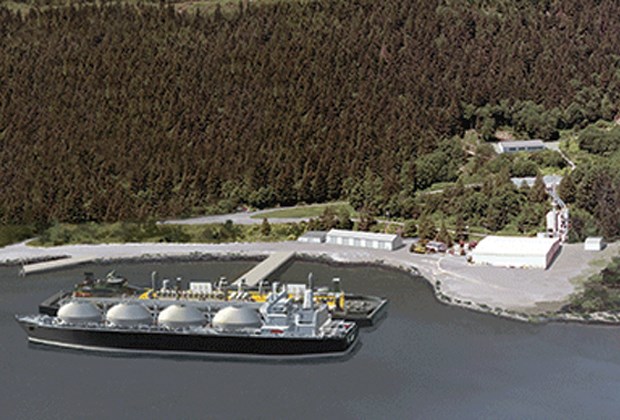The federal government gave its stamp of approval to the $1.6-billion Woodfibre liquefied natural gas project Friday.
Exporting and processing 2.1 million tonnes of LNG each year from the former pulp mill site southwest of Squamish is unlikely to hurt the environment, according to a release from Catherine McKenna, Minister of Environment and Climate Change.
McKenna’s assessment doesn’t account for the plant’s “incredibly environmentally destructive” cooling system, argued West Vancouver lawyer Tom Rafael. “I’m extremely disappointed and very sorry the minister did not thoroughly use a science-based environmental assessment,” he said.
Winning environmental approval from the federal government was the last major hurdle to clear for the polarizing project, which can start launching 40 double-hulled LNG-bearing tankers to Asia each year, beginning as early as 2017.
Rather than uniform opposition, there was “a variety of different opinions” on the project, according to Jonathan Wilkinson, MP for North Vancouver and parliamentary secretary to the minister of environment and climate change.
Because the plant will be powered by Hydro, not natural gas, its level of greenhouse gas emissions will be comparatively low, according to Wilkinson.
The MP said he personally stands by the decision, which he added is “based on science and it’s based on data.”
The switch from natural gas to electricity should result in an 80 per cent reduction in greenhouse gas emissions, according to Woodfibre.
However, the federal government likely underestimated methane emissions, according to environmental research group the Pembina Institute.
Methane leakage at a comparable facility in the United States is reported to be five times higher than the government is anticipating at Woodfibre, according to the institute’s report.
West Vancouver-Sea to Sky Liberal MLA Jordan Sturdy said he’s pleased with the results. “It appears to be about as good an export facility as you’re going to see,” he said. “If Woodfibre was not approved, it’s hard to see how any other facility could be approved.”
Environmentalist Eoin Finn blasted the assessment, calling the approval “a stain on our international reputation.”
The project was approved despite overwhelming opposition, largely related to potential impact on marine traffic and Howe Sound mammals. Still, Finn said he plans to keep up the fight.
West Vancouver-Sunshine Coast-Sea to Sky Country MP Pamela Goldsmith-Jones said she had one message for community leaders Friday afternoon: “we’re all in this together.” She promised to be vigilant in maintaining ecological health and marine safety.
For Woodfibre, “the real work is just beginning,” stated Byng Giraud, vice-president of corporate affairs for Woodfibre LNG in a press release. The company will incorporate conditions from the environmental review into its design and construction of the refinery, according to Giraud.
The project should create about 650 construction jobs during the building phase and more than 100 jobs once the plant is operational.
When first pitched, the project got a rancorous reception from West Vancouver Mayor Michael Smith, who recalled assurances he once received from oil giant ExxonMobil about infinitesimal chances of a spill.
Reached Friday, Smith said he was disappointed. “We’ve stated our case that Howe Sound should be protected,” he said, noting the body of water is a mecca for outdoor recreation. “To take a chance on losing that, I think, is quite sad.”
Other West Van councillors raised concerns over a process that could pump 17,000 cubic metres of heated and chlorinated seawater back into Howe Sound every hour.
Those concerns are unfounded, according to Woodfibre project director Alex Brigden, who said the percentage of chlorine used is lower than in drinking water.
The project won approval from both B.C. and the Squamish Nation – on whose land the site is located – in October 2015. Woodfibre still needs approvals and permits from Fisheries and Oceans Canada and Transport Canada, both of which participated in the federal review.
– with files from Brent Richter and Jane Seyd



